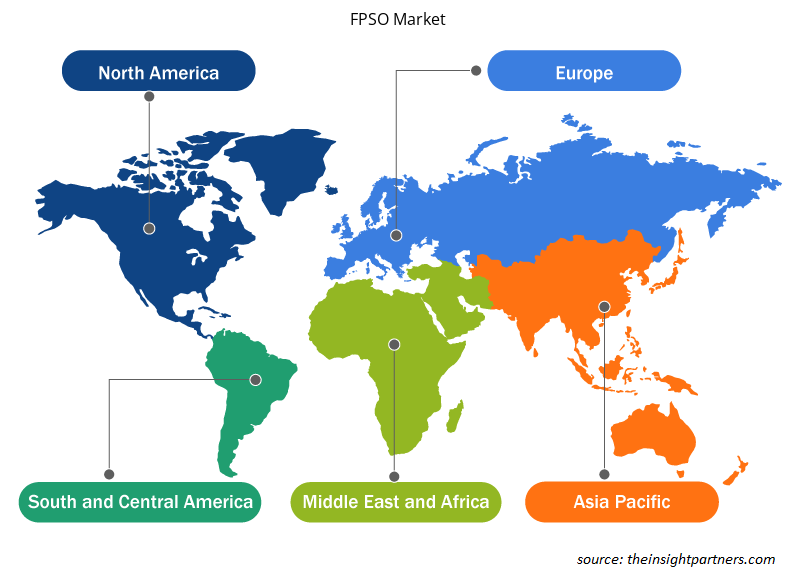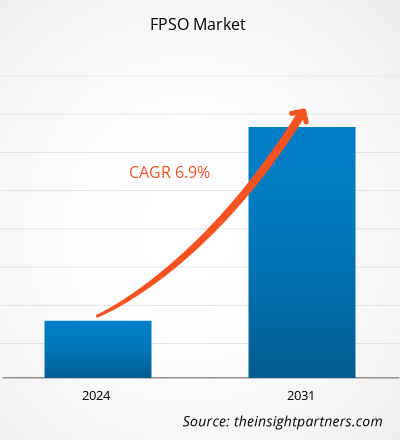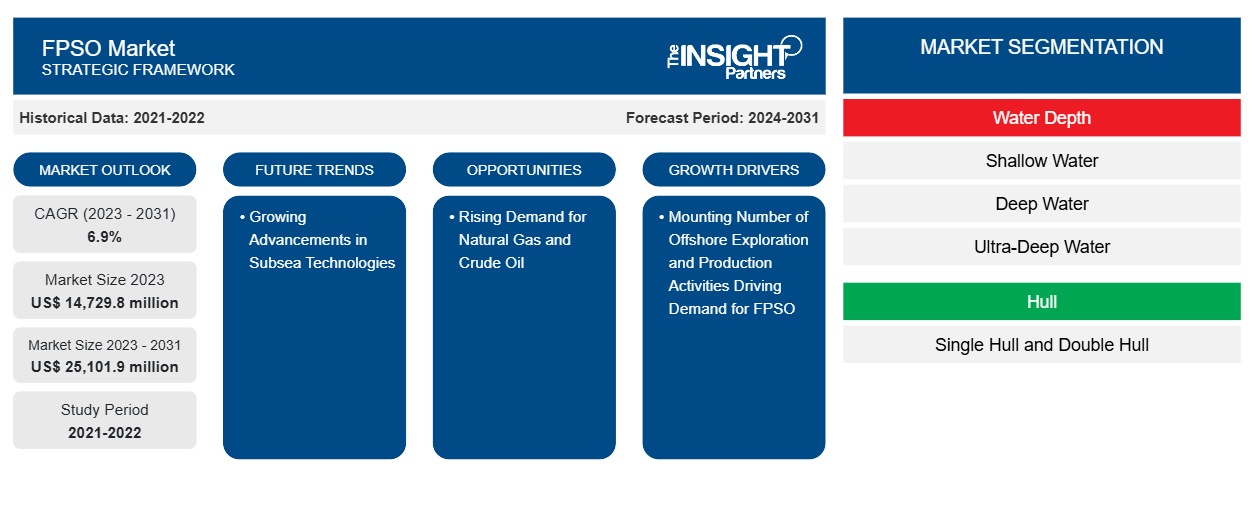Si prevede che la dimensione del mercato FPSO raggiungerà i 25.101,9 milioni di dollari entro il 2031, rispetto ai 14.729,8 milioni di dollari del 2023. Si prevede che il mercato registrerà un CAGR del 6,9% nel 2023-2031. Il crescente sviluppo del settore petrolifero e del gas e l'aumento delle attività di esplorazione petrolifera e del gas sono alcune altre tendenze per il mercato FPSO.
Analisi di mercato FPSO
La crescente espansione dei progetti di petrolio e gas è il fattore chiave che stimola la domanda di FPSO. La domanda di FPSO, in particolare offshore, unita a un prezzo del petrolio moderatamente stabile abbinato a un'impennata delle attività di esplorazione offshore e produzione di petrolio dovrebbe stimolare una forte crescita della domanda globale di navi FPSO nei prossimi cinque anni. Alcune delle principali aziende FPSO come Total Energies, Petrobras, CNOOC Ltd, Equinor ASA ed Exxon Mobil tra le altre si stanno concentrando sulla guida dello sviluppo del mercato FPSO.
Panoramica del mercato FPSO
Le aziende di esplorazione di petrolio e gas, come Equinor ASA, si stanno concentrando sulle attività di esplorazione di petrolio e gas in acque profonde e ultra-profonde. Ad esempio, nel 2022, Shell ha avviato progetti sulla produzione di petrolio nel campo PowerNap. Inoltre, le aziende di petrolio e gas stanno implementando nuove tecnologie grazie agli sviluppi nelle tecnologie offshore, come torrette separabili, design di scafo cilindrico e design a doppio scafo. Inoltre, gli sviluppi tecnologici in FPSO rispetto ad altri sistemi di produzione, come la digitalizzazione di FPSO e la penetrazione dell'automazione e del lotto nel settore petrolifero e del gas, aumentano l'attenzione delle aziende di mercato sulle attività di R&S e lo sviluppo di nuovi prodotti genererebbe tendenze per la crescita del mercato FPSO nei prossimi anni.
Personalizza questo report in base alle tue esigenze
Riceverai la personalizzazione gratuita di qualsiasi report, comprese parti di questo report, o analisi a livello nazionale, pacchetto dati Excel, oltre a usufruire di grandi offerte e sconti per start-up e università
-
Scopri le principali tendenze di mercato in questo rapporto.Questo campione GRATUITO includerà analisi di dati che spaziano dalle tendenze di mercato alle stime e alle previsioni.
Driver e opportunità del mercato FPSO
Il crescente numero di attività di esplorazione e produzione offshore stimola la domanda di FPSO
Negli ultimi decenni, l'esplorazione e la produzione di petrolio e gas offshore si sono notevolmente intensificate. Inoltre, le scoperte di nuove riserve di petrolio e gas si stanno espandendo in modo esponenziale in tutto il mondo. Crescente presenza di importanti società di estrazione di petrolio e gas, come Petrobras, nelle attività di esplorazione e produzione offshore. In Petrobras, la maggior parte delle riserve di petrolio si trova in campi offshore, che hanno diretto le attività di perforazione. Inoltre, secondo l'IEA, entro il 2040, le spese in conto capitale annuali per le attività di produzione di petrolio e gas offshore in Brasile ammonteranno a 60 miliardi di dollari USA. Inoltre, il crescente numero di sfruttamenti di riserve petrolifere marginali in aree remote offshore, insieme alla flessibilità delle FPSO di operare senza il supporto di una struttura fissa, stimola la crescita del mercato.Petrobras, in offshore exploration and production activities. In Petrobras, most of the oil reserves are in offshore fields, which has directed the drilling activities. In addition, according to the IEA, by 2040, annual capital expenses for offshore oil and exploitations of marginal oil reserves in remote offshore areas, along with the flexibility of FPSOs to operate without the support of a fixed structure, boosts market growth.
Domanda crescente di gas naturale e petrolio greggio: un’opportunità nel mercato FPSO
La crescente richiesta di petrolio greggio e gas naturale è in continuo aumento, il che è uno dei motivi principali alla base della crescita del mercato FPSO. Si prevede che la domanda di petrolio registrerà un trend di crescita nel periodo 2022-2025 nei paesi OCSE, secondo l'OPEC. Tuttavia, si prevede che la domanda nei paesi non OCSE aumenterà di 22,5 mb/giorno durante il periodo di previsione fino al 2045. Il rapporto dell'OPEC ha identificato che si prevede che il gas naturale sarà il combustibile fossile in più rapida crescita e sarà il secondo maggiore contributore al mix energetico, che si prevede avrà una quota di circa il 25% nel 2045. Nei prossimi anni, si prevede che l'Asia Pacifica registrerà un'elevata domanda di gas naturale a causa del crescente utilizzo di gas naturale in diversi settori industriali. Pertanto, si prevede che la crescente domanda di gas naturale e petrolio greggio a livello globale offrirà opportunità valide per la crescita del mercato FPSO nei prossimi anni.
Analisi della segmentazione del rapporto di mercato FPSO
I segmenti chiave che hanno contribuito alla derivazione dell'analisi di mercato FPSO sono la profondità dell'acqua, lo scafo, l'ormeggio e la costruzione.
- In base alla profondità dell'acqua, il mercato FPSO è stato suddiviso in acque basse, acque profonde e acque ultra-profonde. Il segmento delle acque basse ha detenuto una quota di mercato maggiore nel 2023.
- In base allo scafo, il mercato FPSO è stato suddiviso in scafo singolo e doppio. Il segmento a doppio scafo ha detenuto una quota di mercato maggiore nel 2023.
- In base all'ormeggio, il mercato FPSO è stato suddiviso in ormeggio diffuso e ormeggio scollegabile. Il segmento dell'ormeggio diffuso ha detenuto una quota di mercato maggiore nel 2023.
- In base alla costruzione, il mercato FPSO è stato suddiviso in di nuova costruzione e convertito. Il segmento di nuova costruzione ha detenuto una quota di mercato maggiore nel 2023.
Analisi della quota di mercato FPSO per area geografica
L'ambito geografico del rapporto sul mercato FPSO è suddiviso principalmente in cinque regioni: Nord America, Asia Pacifico, Europa, Medio Oriente e Africa e Sud America/Sud e Centro America.
La regione del Sud America comprende Brasile, Argentina e il resto del SAM. Il resto del SAM comprende Cile, Colombia, Guatemala e Perù. Gli sviluppi tecnologici hanno avuto un forte impatto sull'economia di Brasile e Argentina, contribuendo in larga misura a farla progredire. L'applicazione del petrolio in Sud America è gradualmente diminuita negli ultimi tre anni. Tuttavia, con la ripresa dell'estrazione di petrolio greggio, è probabile che la condizione cambi e le aziende ora si stanno concentrando su più attività di esplorazione e produzione di petrolio e gas, il che sta guidando la domanda per il mercato FPSO in Sud America.
Approfondimenti regionali sul mercato FPSO
Le tendenze regionali e i fattori che influenzano il mercato FPSO durante il periodo di previsione sono stati ampiamente spiegati dagli analisti di Insight Partners. Questa sezione discute anche i segmenti e la geografia del mercato FPSO in Nord America, Europa, Asia Pacifico, Medio Oriente e Africa e Sud e Centro America.

- Ottieni i dati specifici regionali per il mercato FPSO
Ambito del rapporto di mercato FPSO
| Attributo del report | Dettagli |
|---|---|
| Dimensioni del mercato nel 2023 | 14.729,8 milioni di dollari USA |
| Dimensioni del mercato entro il 2031 | 25.101,9 milioni di dollari USA |
| CAGR globale (2023-2031) | 6,9% |
| Dati storici | 2021-2022 |
| Periodo di previsione | 2024-2031 |
| Segmenti coperti |
Per profondità dell'acqua
|
| Regioni e Paesi coperti |
America del Nord
|
| Leader di mercato e profili aziendali chiave |
|
Densità degli attori del mercato: comprendere il suo impatto sulle dinamiche aziendali
Il mercato FPSO sta crescendo rapidamente, spinto dalla crescente domanda degli utenti finali dovuta a fattori quali l'evoluzione delle preferenze dei consumatori, i progressi tecnologici e una maggiore consapevolezza dei vantaggi del prodotto. Con l'aumento della domanda, le aziende stanno ampliando le loro offerte, innovando per soddisfare le esigenze dei consumatori e capitalizzando sulle tendenze emergenti, il che alimenta ulteriormente la crescita del mercato.
La densità degli operatori di mercato si riferisce alla distribuzione di aziende o società che operano in un particolare mercato o settore. Indica quanti concorrenti (operatori di mercato) sono presenti in un dato spazio di mercato in relazione alle sue dimensioni o al valore di mercato totale.
Le principali aziende che operano nel mercato FPSO sono:
- MODEC, Inc.
- Petrolio Brasileiro SA
- Bumi Armada Berhad
- SBM Offshore NV
- CNOOC limitata
- Totale Energie SE
Disclaimer : le aziende elencate sopra non sono classificate secondo un ordine particolare.

- Ottieni una panoramica dei principali attori del mercato FPSO
Notizie e sviluppi recenti del mercato FPSO
Il mercato FPSO viene valutato raccogliendo dati qualitativi e quantitativi post-ricerca primaria e secondaria, che includono importanti pubblicazioni aziendali, dati associativi e database. Di seguito è riportato un elenco degli sviluppi nel mercato per innovazioni, espansione aziendale e strategie:
- Nel maggio 2023, MODEC, Inc. ha annunciato di voler procedere con l'ingegneria, l'approvvigionamento e la costruzione della nave galleggiante di produzione, stoccaggio e scarico Uaru per il progetto Uaru di ExxonMobil Guyana. (Fonte: MODEC, Inc., comunicato stampa/sito Web aziendale/newsletter)
- Nell'aprile 2024, ExxonMobil ha effettuato un investimento finale per lo sviluppo di Whiptail al largo della Guyana, dopo aver ottenuto le necessarie approvazioni governative e normative. (Fonte: ExxonMobil Corporation, comunicato stampa/sito Web aziendale/newsletter)
Copertura e risultati del rapporto di mercato FPSO
Il rapporto “FPSO Market Size and Forecast (2021–2031)” fornisce un’analisi dettagliata del mercato che copre le seguenti aree:
- Dimensioni del mercato FPSO e previsioni a livello globale, regionale e nazionale per tutti i segmenti di mercato chiave coperti dall'ambito
- Dinamiche di mercato come fattori trainanti, vincoli e opportunità chiave
- Tendenze del mercato FPSO
- Analisi PEST e SWOT dettagliate
- Analisi di mercato FPSO che copre le principali tendenze del mercato, il quadro globale e regionale, i principali attori, le normative e i recenti sviluppi del mercato
- Analisi del settore FPSO, del panorama e della concorrenza, che copre la concentrazione del mercato, l'analisi della mappa di calore, i principali attori e gli sviluppi recenti
- Profili aziendali dettagliati
- Analisi storica (2 anni), anno base, previsione (7 anni) con CAGR
- Analisi PEST e SWOT
- Valore/volume delle dimensioni del mercato - Globale, Regionale, Nazionale
- Industria e panorama competitivo
- Set di dati Excel
Report recenti
Testimonianze
Motivo dell'acquisto
- Processo decisionale informato
- Comprensione delle dinamiche di mercato
- Analisi competitiva
- Analisi dei clienti
- Previsioni di mercato
- Mitigazione del rischio
- Pianificazione strategica
- Giustificazione degli investimenti
- Identificazione dei mercati emergenti
- Miglioramento delle strategie di marketing
- Aumento dell'efficienza operativa
- Allineamento alle tendenze normative























 Ottieni un campione gratuito per - Mercato FPSO
Ottieni un campione gratuito per - Mercato FPSO